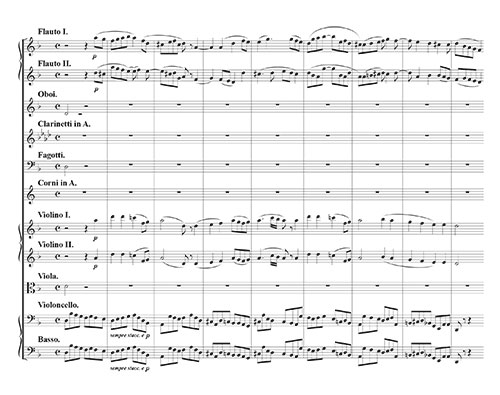A common excerpt on audition repertoire lists, especially for second flute, is Mendelssohn’s 4th Symphony, “Italian.” Usually the passages are from the second movement, Andante con moto, and the last movement Saltarello, Presto. Both movements feature exposed duo passages for the flutes. Though the last movement is very fast and technically tricky, the slow movement duos are fairly complex, requiring full knowledge of the other parts and a keen ear for adjusting one’s playing. It is simply not adequate for a second chair candidate to approach these duos thinking, “I’ll just do what the principal does.” The writing is too complex. However, an audition committee would definitely be impressed with a candidate who knows these passages well enough to make subtle chamber music with the principal on the spot.
Andante con moto
After a two-bar introduction, violins 1 and 2 have the principal theme. Over this is a flute duo obbligato or countermelody while the cellos and basses have a walking bass line played sempre staccato. These ideas make up the core of the movement.

measures 11-18
Getting Started
Play the violin 1 part (if possible, find a friend to play violin 2) to become familiar with the main theme. Then play the bass line (printed in treble clef below) quarter note = 84 and see if you can discreetly take very small breaths between many of the notes without disturbing the rhythm. This is a useful skill to add to your playing.

Measures 12-19 in Treble Clef
(from the cello/bass line)
Now turn to the flute writing. In playing orchestral duos, the chamber music skill of shading (slightly changing the tone/timbre and/or dynamic) allows each voice to be heard when important. In measure 11, the flutes enter on the fourth beat with the first flute predominating slightly with the second flute playing harmony. At the end of measure 12, the first flute gives way to the second flute for the syncopation in the second part. Possible intonation problems may occur on the unison middle octave F on the third and fourth beats of measure 12, then the second flute C# in measure 13, and followed by the perfect fourth at the end of the phrase.
The second flute becomes more prominent in the pickup into measure 14 because the intervals become farther apart. During these measures, the first flute should play one dynamic lower and with less vibrato than the second player.
In measure 15, the parts trade importance with the second flute regaining importance in moving line during the first flute dotted quarter note and then the first flute taking over in the last three eighth notes of the measure.
Both parts are rhythmically in unison in measure 16. The second flute should listen carefully to the G in the middle octave to keep it from being too strong or bright because of the leap of a seventh to get there. It is important that all notes in this passage be homogeneous in color or timbre.
Beginning at the end of measure 17, the flutes play in syncopation, and the dynamic should follow the descending line of the first flute part. The second flute should avoid too much diminuendo though on the lowest octave notes. The principal flute should pay careful attention to the pitch of the middle octave C# (perhaps leaving down some of the fingers on the right hand to lower the pitch and shade the timbre). This type of passage is repeated again at measure 27, and the thoughts above should be carried forward.
Alternatives
Of course, there are a number of other options in terms of balancing the voices. Just because second flute has the harmony part, it does not always mean it should be secondary to the first part. The great conductor George Szell of the Cleveland Orchestra frequently doubled the second wind parts so they could emerge. The idea is that the harmony parts could sometimes be louder as they tend to be lower and hidden in the texture.
Breathing
At times, flutes should stagger the breathing which means basically to not breathe at the same time. This is especially true when both are playing in unison. In these duos, with the exception of the eighth rest in measure 13, the musical intention is that there is a quasi-Baroque streaming of the differing voices, and therefore breaths should be staggered to avoid gaps. These passages have to fit into a tight musical rhythmic framework, which is actually dictated by the eighth note bass line, so breaths should be very quick.
Subtle
It is important to note that this type of ensemble playing is a subtle art, and the shading between voices should be done only on the level of implication. Neither voice should overstate their role, unless exaggeration of some kind is called for. Amount, concept, and consistency of vibrato should be as similar as possible between the flutes, and there should not be any general discrepancies between the players with regard to dynamic range. For example, one player should not play consistently louder than the other.
As with many obbligato passages, overall balance is an important issue, and the conductor should dictate this. The duo might be asked to play generally louder, while the violins should stay more in the background. If the conductor is silent on the issue of dynamics, the two flute players should make a plan for executing these passages with nuance and clarity.
Felix Mendelssohn’s 4th Symphony is a remarkably unusual work in one respect: it is one of the only symphonies in the mainstream symphonic repertoire to begin in a major key and end in the parallel minor – A major to A minor.






